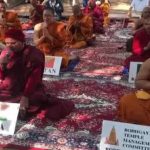Sabarimala Case : A brief History and Timeline
Today the Supreme Court is passing a judgment on whether women between the ages of 10 and 50 should be allowed to enter Kerala’s Sabarimala temple. A five-judge Constitution bench, headed by Chief Justice of India Dipak Misra, is examining the legality of a provision in the Kerala Hindu Places of Public Worship (Authorisation of Entry) Rules, 1965, which authorises the restriction.
The bench, which also comprises Justices R F Nariman, A M Khanwilkar, D Y Chandrachud and Indu Malhotra, had reserved its verdict in the case on August 2 this year. A total of four judgments will be delivered today. Justice Khanwilkar will concur with one of the other judges. The CJI has said that Justice Malhotra has written a dissenting verdict.
In the past three decades, this custom has evoked random resistance and protest from various segments of society. And triggered a long legal wrangle. Let us look at the brief history of the case and timeline. –
1991
Kerala High Court upholds an age-old restriction on women of a certain age-group entering Sabarimala temple. A two-judge bench decrees (on April 5) that the prohibition by the Travancore Devaswom Board that administers the hill shrine does not violate either the Constitution or a pertinent 1965 Kerala law. Reason: the ban was for women (even before 1950, as per the testimony of the vintage temple’s chief priest) between the ages of 10 and 50, not as a class.
2006
A famed astrologer conducts a temple-centric assignment called ‘Devaprasnam’, and declares having found signs of a woman’s entry into the temple sometime ago.
2006
Kannada actress-politician Jayamala claims publicly that she had entered the precincts of Sabarimala in 1987 as a 28-year-old. Even touched the deity inside the sanctum sanctorum as part of a film shoot, she adds, stating this was done in connivance with the priest.
2006
The allegation led the Kerala government to probe the matter through its crime branch, but the case was later dropped.
2008
Kerala’s LDF government files an affidavit supporting a PIL filed by women lawyers questioning the ban on the entry of women in Sabarimala
2016
The India Young Lawyers Association files a PIL with the Supreme Court, contending that Rule 3(b) of the Kerala Hindu Places of Public Worship (Authorisation of Entry) Rules 1965 that states “Women who are not by custom and usage allowed to enter a place of public worship shall not be entitled to enter or offer worship in any place of public worship” violates constitutional guarantees of equality, non-discrimination and religious freedom.
2016
In November 2016 Kerala’s Left Front government favours the entry of women of all age groups filing an affidavit to the effect.
2018
Supreme Court Chief Justice Dipak Misra, hearing the PIL, questions the temple’s authority to deny entry to a particular section of women.
The case is being heard by a constitution bench headed by Misra along with Justices Rohinton Nariman, AM Khanwilkar, DY Chandrachud and Indu Malhotra. The court held that Sabarimala pilgrims could not be a separate sect or religious denomination. The customs are subjected to constitutional validity and prohibition of women entry to temple in violation of the Fundamental Rights. Justice Chandrachud claimed, “Your right to pray as a woman is not dependent on any law, it is a constitutional right”. He further added that notification issued under the rules prescribing the age restrictions on women entry as “arbitrary on the face of it”.
Must Read : Sabarimala : Significance of 18 steps in the Ayyappa Swamy pilgrimage









